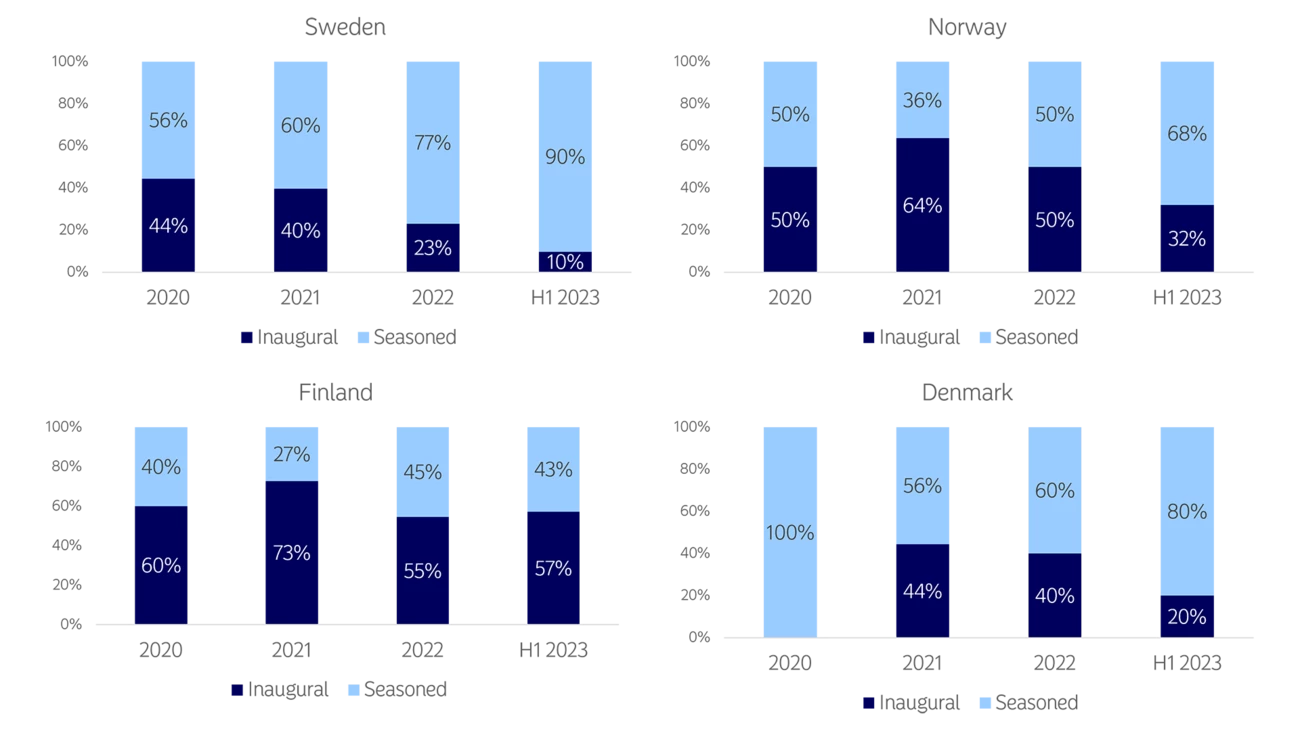These trends in the Nordics can be attributed to a combination of factors, including a generally strong commitment to corporate sustainability, transparency and robust regulatory regulation. In addition, the composition of sustainable debt issuance in the region has likely also played a role. The Nordic market has witnessed a relatively diverse range of issuers, particularly of sustainability-linked bonds, compared to the global market. Moreover, while the global market has witnessed a stagnation in growth of sustainability-linked issuances over the past year, the Nordic market has continued to see growth in this segment, with new issuers becoming increasingly able to access sustainable finance.
Green bonds, however, continue to dominate in the Nordic market, taking an 83% share of sustainable volume in H1 2023. With green bonds being the dominant share of the market and the longest-standing sustainable format, we begin there in our search for expectations for the maturing market.
Green bonds: Sweden leads the charge
When it comes to the strength of the green bond market in particular, Sweden outshines its Nordic neighbors. The country boasts the highest number of issuers and amount issued, making it a benchmark for sustainability efforts in the region. Sweden’s advanced green bond market makes it the sixth largest issuer by amount issued since the inception of the green bond market. Only China, Germany, France, USA and the Netherlands beat Sweden in the ranks.
While Sweden tops the Nordics in most aspects of green bond issuance, the country shows the lowest average deal size in the Nordics. Looking at the number of sectors represented in each country suggests that green bonds have permeated more deeply into the Swedish market than elsewhere in the region.
Here’s a closer look at some key figures since the green bond market’s inception:
| | Denmark | Finland | Norway | Sweden |
| Number of green bonds issued | 79 | 63 | 301 | 840 |
| Amount of green bonds issued (EURm) | 31,580 | 24,948 | 56,305 | 83,166 |
| Average deal size (EURm) | 400 | 369 | 187 | 99 |
| Rank in global issuance chart | 16 | 20 | 13 | 6 |
| Number of sectors represented | 9 | 15 | 19 | 30 |
Source: Bloomberg (26.9.2023), data excludes Supranational deals
Norway comes second in the Nordic ranks, with a market two-thirds of the size of Sweden’s by amount issued. The average deal size is larger in Norway, while the number of green bonds issued has been more modest there compared to Sweden. While Finland has the smallest green bond market in the Nordics, the impressive sectoral diversity, given the market size, indicates that green bonds have taken a comfortable hold. To further understand the green bond market across countries, we must also look at how it has developed over time.
Nordic green bond market: A shift from municipalities to corporates
In the Nordics, municipalities were the initial trailblazers in the green bond market. Norway took the lead in kickstarting the Nordic sustainable finance market in 2010 when Kommunalbanken issued its inaugural green bond. The country has since become a seasoned issuer, with over 20 green bonds issued.
The City of Gothenburg followed suit in 2013, opening the Swedish green bond market and consistently issuing at least one bond per year since. In Finland, MuniFin (Kuntarahoitus) played a pivotal role in launching the Finnish sustainable bond market in 2015 and has actively participated since its inception. Denmark stands out from the rest, with a corporate entity, namely Vestas, first entering the market in 2015.
However, the landscape has since evolved, with corporates now dominating the sustainable bond market in most Nordic countries, except for Norway, where financial institutions play the most significant role.
Nordic market maturation: Seasoned issuers take an increasing share
Further underscoring the maturing of the Nordic sustainable bond market, it is noteworthy that the proportion of seasoned vs inaugural issuers is generally increasing year-on-year. This shift towards more seasoned issuers signals a greater level of experience and confidence from both issuers and investors in the region, and propels its continued evolution as participants become more able to push on standards and performance.






